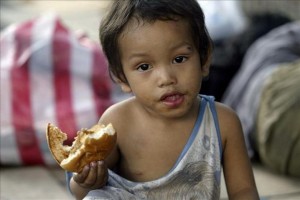More Latino kids in Colorado expected to go hungry

Hunger Free Colorado estimates that 220,000 youngsters in the state suffer from hunger or food insecurity. EFE/File
Denver, Colorado. Jun 15. The rapid growth of child poverty in Colorado has increased hunger and food insecurity for thousands of children in the state, many of them Hispanic, according to figures revealed by the Hunger Free Colorado organization.
“This summer only 7 percent of all the children whose families qualify to receive free food are taking part in these programs. And during the rest of the year, when schools are open, only 38 percent do so,” Rita McCusker, the group’s Community Outreach manager, told Efe.
“There are many reasons why that happens, but there is no reason to explain why children are going hungry in this state,” she said.
The situation, McCusker said, also affects other vulnerable populations, such as single mothers and the elderly living on a fixed income, who, because of the rising cost of food, “are forced to choose between buying food or medicines or paying the rent.”
Hunger Free Colorado, a coalition of some 400 organizations founded three years ago, estimates that 220,000 youngsters in the state suffer from hunger or food insecurity, defined as not knowing when they will get their next meal nor what its quality will be.
Nonetheless, fewer than 15,000 of those childrens have access to free food-distribution programs for minors.
The situation affects above all Hispanic neighborhoods and other minorities in metropolitan Denver and Latino-majority counties in southern Colorado.
For example, in the Denver suburb of Commerce City, 83 percent of the local Latino population lives beneath the federal poverty line, and in all schools in the area at least half the students qualify for free or subsidized meals.
At a state level, in recent years Hunger Free Colorado saw an increase in the number of distribution centers for free meals and a 61-percent increase in the number of people applying for that aid.
In total, the group estimates that at least 16 percent of Colorado’s population suffers from hunger or food insecurity, which means as many as 900,000 people.
In 2011, Hunger Free Colorado provided meals for 1.2 million people and expects to top that number this year.
“Though the end of the school year generally indicates the beginning of three months without classes or homework, for many children it also means the end of healthy meals every day,” the organization’s Executive Director Kathy Underhill said.
“Colorado has a great need for access to nutritional meals, given that Colorado is the state with the biggest increase in child poverty in the nation,” she said.
According to figures provided by the Colorado Children’s Campaign, child poverty in this state has grown by more than 72 percent over the last 10 years.










You must be logged in to post a comment Login